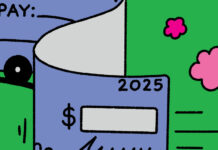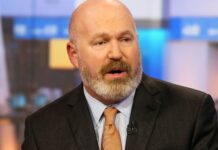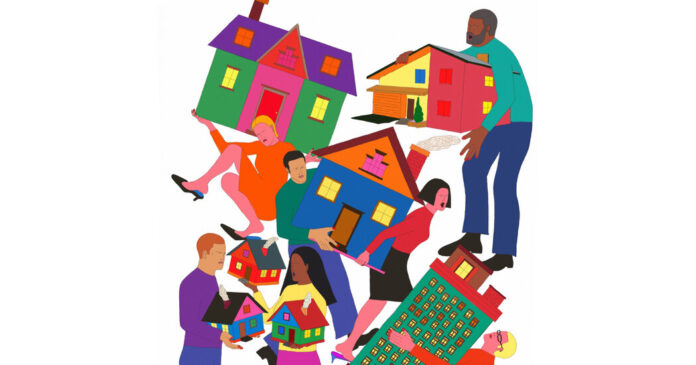High inflation often leads to great anxiety, which is why many Americans are scrambling to insure the cost of one of their most basic, human needs: a home.
But with house prices already at elevated levels and mortgage rates skyrocketing, many buyers may be tempted to jump in before they’re ready — or out of fear that things are only going to get worse.
“There’s this psychological pressure that everything is uncertain,” said Simon Blanchard, an associate professor at Georgetown University’s McDonough School of Business who studies consumer financial decision-making. That can make a need like housing seem concrete, he said.
“It might sound reassuring to focus on the present and fix that part of the budget,” he said. “The danger is that you create a vulnerability by not leaving enough flexibility for later.”
According to the National Association of Realtors, the national median price for existing homes in March was $375,300, up 15 percent from $326,300 a year earlier. Interest rates on 30-year fixed-rate mortgages for the week ended Thursday were 5.10 percent, up from 2.98 percent a year ago, according to Freddie Mac.
That has seriously hurt prospective buyers’ options: With a 10 percent down payment on the average home, the typical monthly mortgage payment is now $1,834, up 49 percent from $1,235 a year ago, with both higher prices and higher interest rates will be accounted for. And that doesn’t include other non-negotiable items like property taxes, home insurance, and mortgage insurance, which are often required on down payments less than 20 percent.
With inflation at a 40-year high and the cost of just about everything soaring, it’s easy to get caught up in the irrationality that is leading some buyers to aggressively inflate prices and skip basic precautions like a home inspection .
“There’s a shortage right now,” said Jake Northrup, a financial planner for young families in Bristol, RI. He said he and his wife decided to wait a year and save more before buying their own home.
Some potential buyers are doing the same — mortgage applications have slowed recently — but the market remains highly competitive due to the country’s chronically low housing supply. This can lead to incorrect assumptions and poor judgment.
So before you head to the open house, it’s time to assess not just what you can spend, but what you should be spending – and the potential costs in the future.
Conduct a budget review.
Before you start scanning deals, it helps to have a solid understanding of what you can afford — and how different price points would affect your ability to save and spend elsewhere.
Some finance experts suggest working backwards: Assume a minimum savings rate — say 15 or 20 percent for retirement, college savings, and other goals — and account for all other recurring debts and expenses in a spreadsheet. Then play around with different house prices to see how they would affect everything else.
“The right mortgage amount isn’t what you get pre-approved, it’s what you can afford,” said Mr. Northrup, the financial planner. “The #1 mistake I see people making when buying a home is not fully understanding how other areas of their financial life are being impacted.”
What is affordable? The answer will, of course, vary based on household, income, family size, and other factors.
State housing authorities have long considered it onerous to spend more than 30 percent of gross income on housing — a figure derived from “a week’s wages for a month’s rent” that became the rule of thumb by the 1920s. This standard was later incorporated into national housing policy as a limit – low-income households paid no more than a quarter of their income for public housing, a ceiling raised to 30 percent in 1981.
Some financial planners may use a similar rough starting point: Don’t spend more than 28 percent of your gross income on all of your living expenses — mortgage payments, property taxes, insurance — and an additional 1 to 2 percent on repairs and maintenance.
That won’t work for everyone, however, especially in high-cost metropolitan areas where it’s often difficult to find rental accommodation within these constraints.
“Take into account all of your monthly expenses and really decide how much you want to spend on housing,” said Tom Blower, a senior financial advisor at Fiduciary Financial Advisors. “I would never encourage a client to strictly stick to a percentage of income to determine how much to spend each month. Rules of thumb are guidelines and something to be followed, but not the be-all and end-all.”
Adjust your expectations.
The rise in interest rates means many people have had to tighten their price ranges — significantly. A $125,000 family who wanted to pay back 20 percent and spend no more than 28 percent of their gross income on housing—roughly $35,000—could comfortably afford a $465,000 home if the interest rate was 3 percent . At 5 percent, that number dwindles to $405,000, according to Eric Roberge, a financial planner and founder of Beyond Your Hammock in Boston. His calculation took into account property taxes, maintenance and insurance.
He generally suggests spending a conservative proportion of household income — no more than about 23 percent — on housing, but acknowledges that in many places this is difficult. “Our affordability calculation is not changing,” said Mr. Roberge. “But the big jump in price is changing what’s actually affordable.”
There are other considerations. As many Americans move from cities to larger spaces in the suburbs, you also need to consider how much more it will cost to run and furnish that home, for example, or how much you’ll have to spend extra on transportation.
Beware of the fixer upper and other hidden costs.
Properties in less than ideal condition are tempting for those hoping to save some money, but supply chain problems and other issues make that much more difficult, experts said.
“I’ve had clients recently who have tried to partially circumvent the affordability issue by buying homes that need significant improvement,” said Melissa Walsh, financial planner and founder of Clarity Financial Design in Sarasota, Fla. “Because contractors are hard to come by and material prices have increased rapidly, these customers are finding that buying a fixer upper may not be the bargain it was a few years ago.”
She suggests putting big money aside — two clients have spent more than double their original estimate on renovations this year.
Be careful with an adjustable rate mortgage.
Adjustable-rate mortgages generally have lower interest rates than fixed-rate mortgages for a fixed period of time, often three or five years. After that, they revert to the prevailing rate and then change on a schedule, usually every year.
The average interest rate on a 5/1 adjustable-rate mortgage — fixed for the first five years and changing each year thereafter — was 3.78 percent for the week ended Thursday, according to Freddie Mac. Last year it was 2.64 percent.
More buyers are considering adjustable-rate mortgages: They accounted for more than 9 percent of all mortgage applications in the week ended April 22, double from three months ago and the highest since 2019, the Mortgage Bankers Association said.
But they’re definitely not for everyone. “The typical borrower is someone who doesn’t expect to stay in the property long,” said Kevin Iverson, president of Denver’s Reed Mortgage.
If you know you’re going to sell before your mortgage rate adjusts, it may be a suitable loan. But there’s no telling what interest rates will be like five years from now, and the sudden surge in higher interest rates marginalized many borrowers during the 2008 financial crisis (although today’s ARMs are generally safer than the products sold back then ).
Be even more wary of so-called alternative finance – contract agreements and home loans regularly used to purchase prefab homes – which often lack typical consumer protections.
Don’t forget everything else.
The expense of simply moving into a home may feel the most painful in the short term, but other expenses can be just as thorny down the road.
A recent paper by Fannie Mae economists analyzed the costs typically incurred over a seven-year home ownership lifecycle and found that the largest contributors include almost everything but the mortgage. Other ongoing expenses — utilities, property taxes and home renovations — together account for about half of a borrower’s costs, while transaction costs accounted for 20 percent, the economists found.
They used credit data from 2020, where the average first-time homebuyer was 36 years old with a monthly income of $7,453 and bought a home for $291,139 with an 11 percent down payment. The actual mortgage — not including repayment of the principal loan amount — accounts for about 30 percent of the total cost over that seven-year period.
Their conclusion: “Borrowing is a large part of the cost of owning a home, but those costs are often overshadowed by utilities, property taxes, home repairs, and one-time fees paid to various parties involved in buying and selling a home.”















